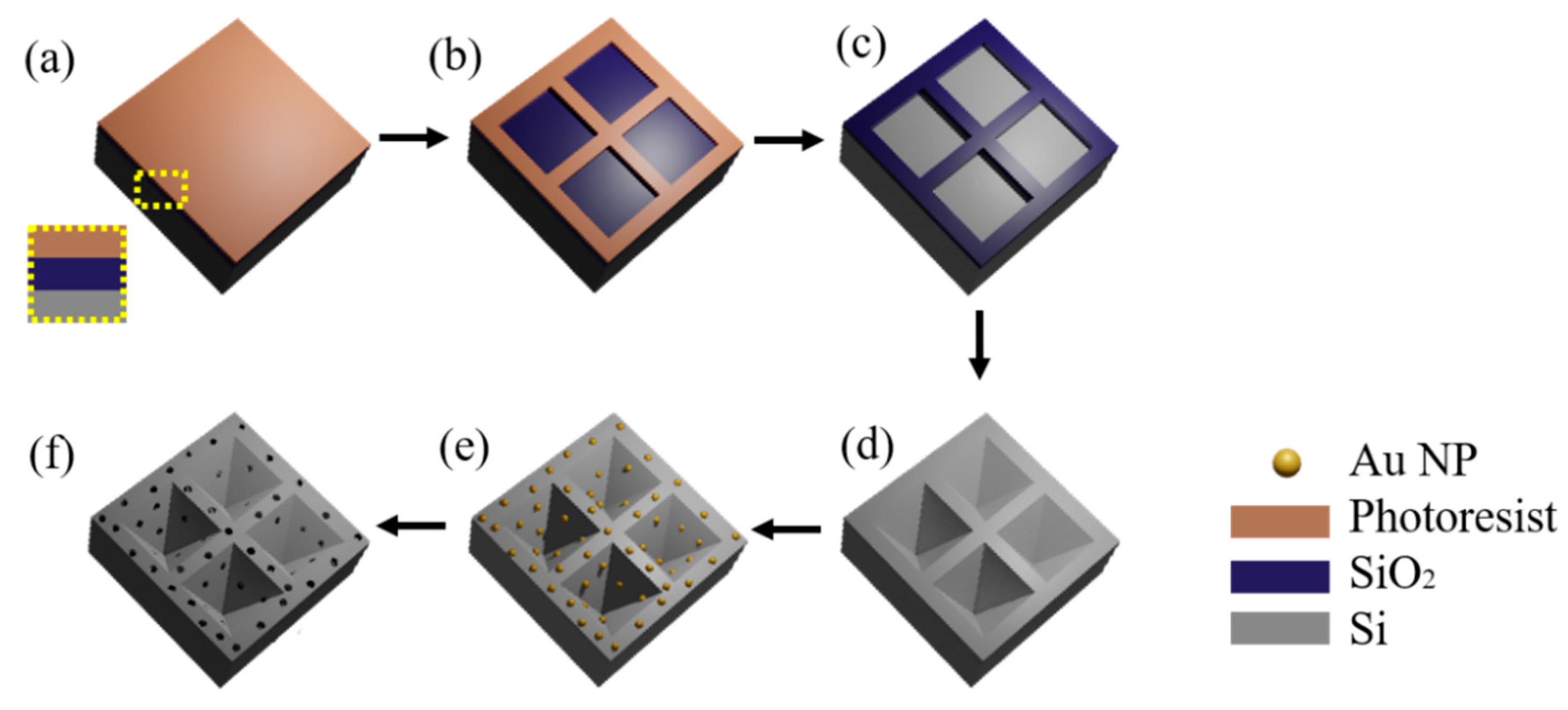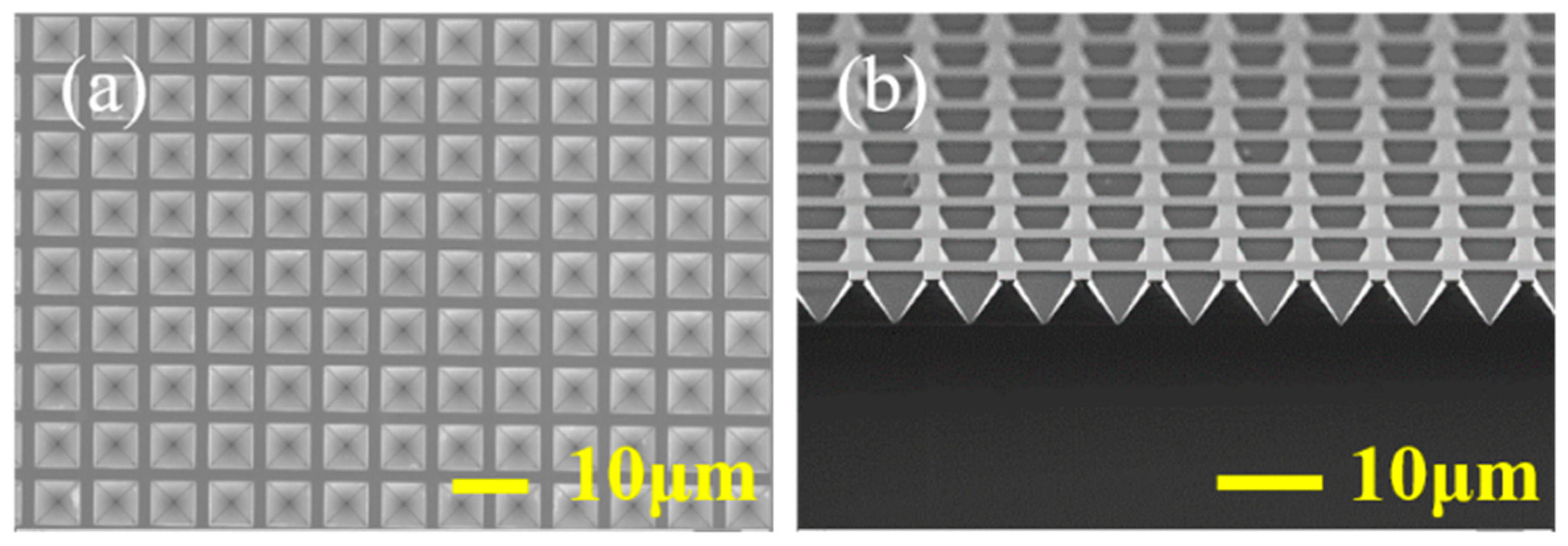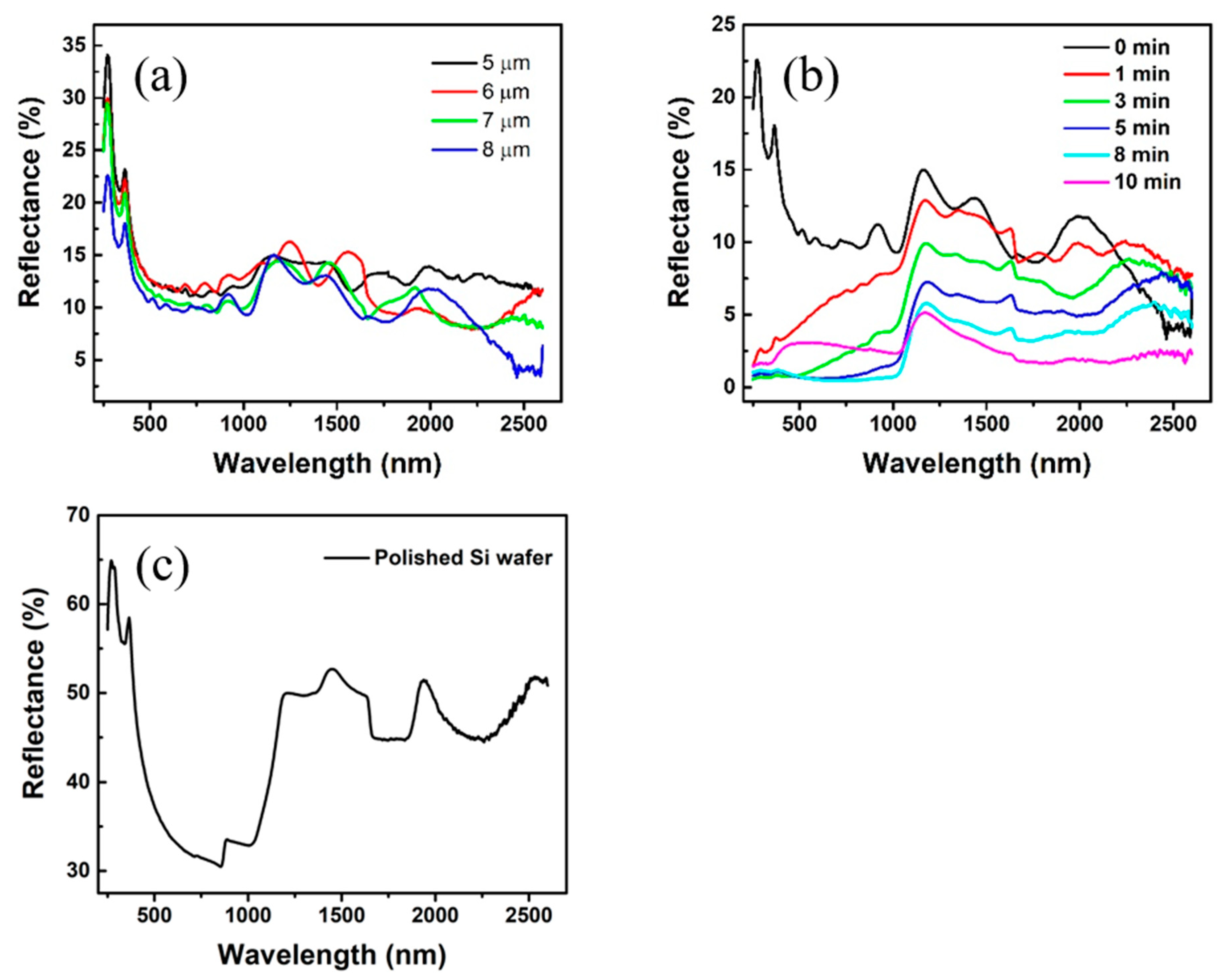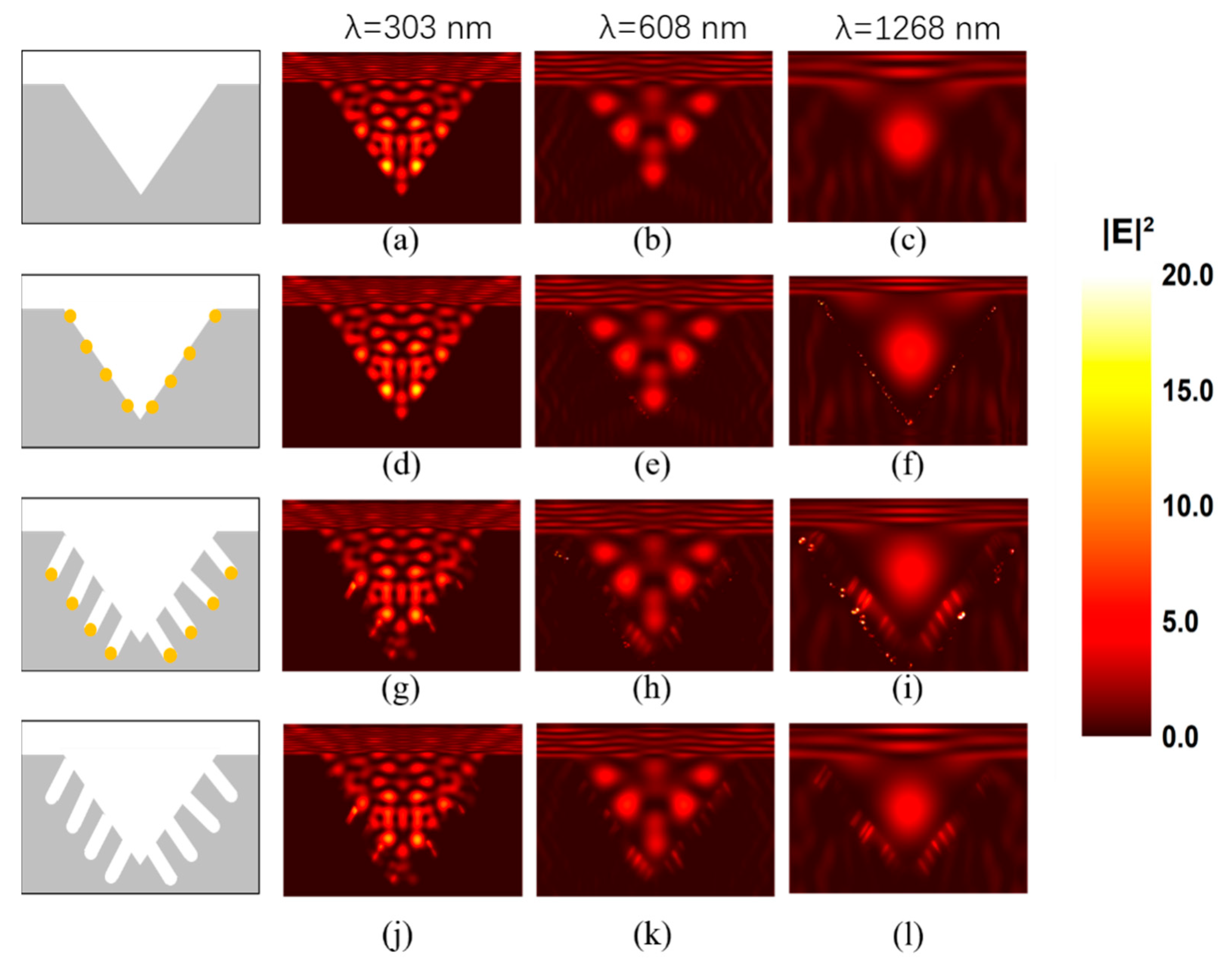Fabrication and Characterization of Inverted Silicon Pyramidal Arrays with Randomly Distributed Nanoholes
Abstract
:1. Introduction
2. Materials and Manufacturing Methods
3. Results and Discussion
4. Conclusions
Author Contributions
Funding
Data Availability Statement
Conflicts of Interest
References
- Garin, M.; Heinonen, J.; Werner, L.; Pasanen, T.P.; Vahanissi, V.; Haarahiltunen, A.; Juntunen, M.A.; Savin, H. Black-Silicon Ultraviolet Photodiodes Achieve External Quantum Efficiency above 130. Phys. Rev. Lett. 2020, 125, 117702. [Google Scholar] [CrossRef] [PubMed]
- Green, M.A.; Bremner, S.P. Energy conversion approaches and materials for high-efficiency photovoltaics. Nat. Mater. 2016, 16, 23–34. [Google Scholar] [CrossRef] [PubMed]
- Holst, G.C.; Krapels, K.A.; Teaney, B.P.; Reynolds, J.P. Reflective band image generation in the night vision integrated performance model. Int. Soc. Opt. Photonics 2016, 9820, 982006. [Google Scholar]
- Capasso, F.; Tsang, W.T.; Hutchinson, A.L.; Williams, G.F. Enhancement of electron impact ionization in a superlattice: A new avalanche photodiode with a large ionization rate ratio. Appl. Phys. Lett. 1982, 40, 38–40. [Google Scholar] [CrossRef]
- Yong, S.T.; Mosset, J.B.; Loude, J.F.; Yong, C.; Morel, C. Characterization of two deep-diffusion avalanche photodiode array prototypes with different optical coatings. IEEE Trans. Nucl. Sci. 2004, 51, 2279–2283. [Google Scholar]
- Yao, T.-F.; Wu, P.-H.; Wu, T.-M.; Cheng, C.-W.; Yang, S.-Y. Fabrication of anti-reflective structures using hot embossing with a stainless steel template irradiated by femtosecond laser. Microelectron. Eng. 2011, 88, 2908–2912. [Google Scholar] [CrossRef]
- Huang, Z.; Song, X.; Zhong, S.; Xu, H.; Luo, W.; Zhu, X.; Shen, W. 20.0% Efficiency Si Nano/Microstructures Based Solar Cells with Excellent Broadband Spectral Response. Adv. Funct. Mater. 2016, 26, 1892–1898. [Google Scholar] [CrossRef]
- Kanevskii, V.I.; Kolienov, S.O. Analysis of electrodynamic conditions of photo-assisted nanoscale polishing of silica covered with calcium hypochlorite: Theoretical analysis. J. Mod. Opt. 2020, 67, 242–251. [Google Scholar] [CrossRef]
- Wang, L.; Chen, K.; Tong, H.; Wang, K.; Tao, L.; Zhang, Y.; Zhou, X. Inverted pyramid Er3+ and Yb3+ Co-doped TiO2 nanorod arrays based perovskite solar cell: Infrared response and improved current density. Ceram. Int. 2020, 46, 12073–12079. [Google Scholar] [CrossRef]
- Yu, M.; Huang, W.; Li, P.; Huang, H.; Zhang, K.; Zhu, X. Morphology evolution of TiO2 nanotubes with additional reducing agent: Evidence of oxygen release. Electrochem. Commun. 2019, 98, 28–32. [Google Scholar] [CrossRef]
- Kim, K.; Song, Y.; Oh, J. Nano/micro dual-textured antireflective subwavelength structures in anisotropically etched GaAs. Opt. Lett. 2017, 42, 3105–3108. [Google Scholar] [CrossRef] [PubMed]
- Sun, C.-H.; Jiang, P.; Jiang, B. Broadband moth-eye antireflection coatings on silicon. Appl. Phys. Lett. 2008, 92, 061112. [Google Scholar] [CrossRef] [Green Version]
- Okabe, T.; Yano, T.; Yatagawa, K.; Taniguchi, J. Polyimide moth-eye nanostructures formed by oxygen ion beam etching for anti-reflection layers. Microelectron. Eng. 2021, 242–243, 111559. [Google Scholar] [CrossRef]
- Chen, J.-Y.; Yu, M.-H.; Chang, S.-F.; Wen Sun, K. Highly efficient poly(3,4-ethylenedioxythiophene):poly(styrenesulfonate)/Si hybrid solar cells with imprinted nanopyramid structures. Appl. Phys. Lett. 2013, 103, 133901. [Google Scholar] [CrossRef] [Green Version]
- Tsujino, K.; Matsumura, M. Boring Deep Cylindrical Nanoholes in Silicon Using Silver Nanoparticles as a Catalyst. Adv. Mater. 2005, 17, 1045–1047. [Google Scholar] [CrossRef]
- Oh, J.; Yuan, H.C.; Branz, H.M. An 18.2%-efficient black-silicon solar cell achieved through control of carrier recombination in nanostructures. Nat. Nanotechnol. 2012, 7, 743–748. [Google Scholar] [CrossRef]
- Lv, J.; Zhang, T.; Zhang, P.; Zhao, Y.; Li, S. Review Application of Nanostructured Black Silicon. Nanoscale Res. Lett. 2018, 13, 110. [Google Scholar] [CrossRef] [PubMed]
- Yang, Z.; Feng, B.; Lu, B.; Chen, Y.; Li, W.; Zhang, W.; Li, T. A study of nano-structural effect on the polarization characteristics of metallic sub-wavelength grating polarizers in visible wavelengths. Microelectron. Eng. 2020, 227, 111327. [Google Scholar] [CrossRef]
- Li, H.; Niu, J.; Zhang, C.; Niu, G.; Ye, X.; Xie, C. Ultra-Broadband High-Efficiency Solar Absorber Based on Double-Size Cross-Shaped Refractory Metals. Nanomaterials 2020, 10, 552. [Google Scholar] [CrossRef] [Green Version]
- Gao, K.; Liu, Y.; Fan, Y.; Shi, L.; Zhuang, Y.; Cui, Y.; Yuan, S.; Wan, Y.; Shen, W.; Huang, Z. High-Efficiency Silicon Inverted Pyramid-Based Passivated Emitter and Rear Cells. Nanoscale Res. Lett. 2020, 15, 174. [Google Scholar] [CrossRef] [PubMed]
- Papet, P.; Nichiporuk, O.; Kaminski, A.; Rozier, Y.; Kraiem, J.; Lelievre, J.F.; Chaumartin, A.; Fave, A.; Lemiti, M. Pyramidal texturing of silicon solar cell with TMAH chemical anisotropic etching. Sol. Energy Mater. Sol. Cells 2006, 90, 2319–2328. [Google Scholar] [CrossRef]
- Lin, Y.-K.; Chen, Y.-S.; Hsueh, C.-H. Combined metal-assisted chemical etching and anisotropic wet etching for anti-reflection inverted pyramidal cavities on dendrite-like textured substrates. Results Phys. 2019, 12, 244–249. [Google Scholar] [CrossRef]
- Rahman, T.; Navarro-Cia, M.; Fobelets, K. High density micro-pyramids with silicon nanowire array for photovoltaic applications. Nanotechnology 2014, 25, 485202. [Google Scholar] [CrossRef] [Green Version]
- Kalogirou, S.A. Solar thermal collectors and applications. Prog. Energy Combust. Sci. 2004, 30, 231–295. [Google Scholar] [CrossRef]
- Razykov, T.M.; Ferekides, C.S.; Morel, D.; Stefanakos, E.; Ullal, H.S.; Upadhyaya, H.M. Solar photovoltaic electricity: Current status and future prospects. Sol. Energy 2011, 85, 1580–1608. [Google Scholar] [CrossRef]
- Zhang, Z.; Martinsen, T.; Liu, G.; Tayyib, M.; Cui, D.; Boer, M.J.; Karlsen, F.; Jakobsen, H.; Xue, C.; Wang, K. Ultralow Broadband Reflectivity in Black Silicon via Synergy between Hierarchical Texture and Specific-Size Au Nanoparticles. Adv. Opt. Mater. 2020, 8, 2000668. [Google Scholar] [CrossRef]
- Gupta, P.P.A. Chandra Shekhar Sharma, Surface Texturing of Silicon {100} in an Extremely Low Concentration TMAH for Minimized Reflectivity. ECS J. Solid State Sci. Technol. 2019, 8, P622–P628. [Google Scholar] [CrossRef]
- Campbell, P.; Green, M.A. Light trapping properties of pyramidally textured surfaces. J. Appl. Phys. 1987, 62, 243–249. [Google Scholar] [CrossRef]
- Omer, A.A.A.; He, Z.; Hong, S.; Chang, Y.; Yu, J.; Li, S.; Ma, W.; Liu, W.; El Kolaly, W.; Chen, R. Ultra-Thin Silicon Wafers Fabrication and Inverted Pyramid Texturing Based on Cu-Catalyzed Chemical Etching. Silicon 2020, 13, 351–359. [Google Scholar] [CrossRef]
- Amalathas, A.P.; Alkaisi, M.M. Efficient light trapping nanopyramid structures for solar cells patterned using UV nanoimprint lithography. Mater. Sci. Semicond. Process. 2017, 57, 54–58. [Google Scholar] [CrossRef]
- Chen, K.; Zha, J.; Hu, F.; Ye, X.; Zou, S.; Vähänissi, V.; Pearce, J.M.; Savin, H.; Su, X. MACE nano-texture process applicable for both single- and multi-crystalline diamond-wire sawn Si solar cells. Sol. Energy Mater. Sol. Cells 2019, 191, 1–8. [Google Scholar] [CrossRef] [Green Version]
- Romano, L.; Kagias, M.; Vila-Comamala, J.; Jefimovs, K.; Tseng, L.T.; Guzenko, V.A.; Stampanoni, M. Metal assisted chemical etching of silicon in the gas phase: A nanofabrication platform for X-ray optics. Nanoscale Horiz. 2020, 5, 869–879. [Google Scholar] [CrossRef] [Green Version]
- Romano, L.; Stampanoni, M. Microfabrication of X-ray Optics by Metal Assisted Chemical Etching: A Review. Micromachines 2020, 11, 589. [Google Scholar] [CrossRef]
- Jiang, B.; Dai, H.; Zhao, Q.; Lin, J.; Chu, L.; Li, Y.; Fu, P.; Wu, G.; Ji, J.; Li, M. The path of mass transfer during Au thin film-assisted chemical etching by designed surface barriers. RSC Adv. 2017, 7, 11522–11527. [Google Scholar] [CrossRef] [Green Version]
- Li, H.; Ye, T.; Shi, L.; Xie, C. Fabrication of ultra-high aspect ratio (>160:1) silicon nanostructures by using Au metal assisted chemical etching. J. Micromech. Microeng. 2017, 27, 124002. [Google Scholar] [CrossRef]
- Ding, K.; Zhang, M.; Mao, J.; Xiao, P.; Zhang, X.W.; Wu, D.; Zhang, X.J.; Jie, J.S. High-resolution image patterned silicon wafer with inverted pyramid micro-structure arrays for decorative solar cells. Mater. Today Energy 2020, 18, 100493. [Google Scholar] [CrossRef]
- Tang, Q.; Yao, H.; Xu, B.; Ge, J. Enhanced energy conversion efficiency of Al-BSF c-Si solar cell by a novel hierarchical structure composed of inverted pyramids with different sizes. Sol. Energy 2020, 208, 1–9. [Google Scholar] [CrossRef]
- Markel, V. Introduction to the Maxwell Garnett approximation tutorial. J. Opt. Soc. Am. 2016, 33, 1244–1256. [Google Scholar] [CrossRef] [PubMed] [Green Version]







Publisher’s Note: MDPI stays neutral with regard to jurisdictional claims in published maps and institutional affiliations. |
© 2021 by the authors. Licensee MDPI, Basel, Switzerland. This article is an open access article distributed under the terms and conditions of the Creative Commons Attribution (CC BY) license (https://creativecommons.org/licenses/by/4.0/).
Share and Cite
Zhao, Y.; Zhang, K.; Li, H.; Xie, C. Fabrication and Characterization of Inverted Silicon Pyramidal Arrays with Randomly Distributed Nanoholes. Micromachines 2021, 12, 931. https://doi.org/10.3390/mi12080931
Zhao Y, Zhang K, Li H, Xie C. Fabrication and Characterization of Inverted Silicon Pyramidal Arrays with Randomly Distributed Nanoholes. Micromachines. 2021; 12(8):931. https://doi.org/10.3390/mi12080931
Chicago/Turabian StyleZhao, Yue, Kaiping Zhang, Hailiang Li, and Changqing Xie. 2021. "Fabrication and Characterization of Inverted Silicon Pyramidal Arrays with Randomly Distributed Nanoholes" Micromachines 12, no. 8: 931. https://doi.org/10.3390/mi12080931
APA StyleZhao, Y., Zhang, K., Li, H., & Xie, C. (2021). Fabrication and Characterization of Inverted Silicon Pyramidal Arrays with Randomly Distributed Nanoholes. Micromachines, 12(8), 931. https://doi.org/10.3390/mi12080931




